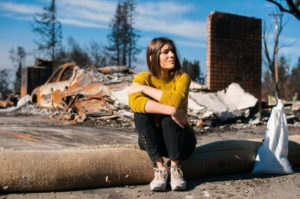September is National Preparedness Month- “Be Prepared, Not Scared”
August 22, 2019
 Prepared for what?
Prepared for what?
Emergencies, power outages, and natural disasters such as floods, earthquakes, and wildfire.
Prepare how?
FIRST MAKE AN EMERGENCY PLAN
Make a plan today. Your family may not be together when a disaster strikes, so it is important to know which types of disasters could affect your area and how you’ll contact one another. Establish a family meeting place that’s familiar and easy to find.
Step 1: Put together a plan by discussing these 3 questions with your family, friends, or household to start your emergency plan.
- What is my shelter plan?
- What is my evacuation route?
- What is my family/household communication plan?
Step 2: Consider the specific needs of your household.
As you prepare your plan discuss your family’s specific needs and responsibilities and how you can work together to care for your children, pets, elderly relatives, or any specific needs like the operation of durable medical equipment. Keep in mind some of the following factors when developing your plan:
- Different ages of members within your household
- Dietary needs
- Medical needs including prescriptions and equipment
- Disabilities or access and functional needs including medical devices and equipment
- Languages spoken
- Cultural and religious considerations
- Pets or service animals
Step 3: Fill out a Family Emergency Plan
Fill out a family emergency plan.
SECOND BUILD A KIT
Basic Disaster Supplies Kit
To assemble your kit, store items in airtight plastic bags and put your entire disaster supplies kit in one or two easy-to-carry containers such as plastic bins or a duffel bag.
A basic emergency supply kit could include the following recommended items:
- Water – one gallon of water per person per day for at least three days, for drinking and sanitation
- Food – at least a three-day supply of non-perishable food
- Battery-powered or hand-crank radio and an NOAA Weather Radio with tone alert
- Flashlight
- First aid kit
- Extra batteries
- Whistle to signal for help
- Dust mask to help filter contaminated air and plastic sheeting and duct tape to shelter-in-place
- Moist towelettes, garbage bags, and plastic ties for personal sanitation
- Wrench or pliers to turn off utilities
- Manual can opener for food
- Local maps
- Cell phone with chargers and a backup battery
Additional Emergency Supplies
Consider adding the following items to your emergency supply kit based on your individual needs:
- Prescription medications
- Non-prescription medications such as pain relievers, anti-diarrhea medication, antacids, or laxatives
- Glasses and contact lens solution
- Infant formula, bottles, diapers, wipes, diaper rash cream
- Pet food and extra water for your pet
- Cash
- Important family documents such as copies of insurance policies, identification, and bank account records saved electronically or in a waterproof, portable container
- Sleeping bag or warm blanket for each person
- Complete change of clothing appropriate for your climate and sturdy shoes
- Household chlorine bleach and medicine dropper to disinfect water
- Fire extinguisher
- Matches in a waterproof container
- Feminine supplies and personal hygiene items
- Mess kits, paper cups, plates, paper towels, and plastic utensils
- Paper and pencil
- Books, games, puzzles, or other activities for children
THIRD PREPARE FINANCIALLY
- Gather financial and critical personal, household, and medical information.
- Consider saving money in an emergency savings account that could be used in any crisis. Keep a small amount of cash at home in a safe place. It is important to have small bills on hand because ATM’s and credit cards may not work during a disaster when you need to purchase necessary supplies, fuel, or food.
- Obtain property (homeowners or renters), health, and life insurance if you do not have them. Review existing policies for the amount and extent of coverage to ensure that what you have in place is what is required for you and your family for all possible hazards. Homeowners insurance does not typically cover flooding, or earthquake so speak to you agent about flood insurance & earthquake insurance.
Sore important documents either in a safety deposit box, an external drive or on the cloud using a secure mobile app to make it easy to access during a disaster.
Having your financial and medical records and important contact information will be crucial to help you start the recovery process quickly. Take time now to safeguard these critical documents.
Household Identification
- Photo ID to prove the identity of household members
- Birth certificates
- Social security card to apply for FEMA disaster assistance
- Military service
- Pet ID tags
Financial and Legal Documentation
- Housing Payments to identify financial records and obligations
- Insurance policies to re-establish financial accounts
- Sources of income to maintain payments and credit
- Tax statements to provide contact information for financial and legal providers & apply for FEMA disaster assistance
Medical Information
- Physician information to provide doctors with health information if medical care is needed
- Copies of health insurance information to ensure existing care continues uninterrupted
- Immunization records
- Medications
Insurance Information
Having insurance for your home or business property is the best way to ensure you will have the necessary financial resources to help you repair, rebuild, or replace whatever is damaged. Document and insure your property now. There are many mobile apps available that let you take photos & document your property and store the information on the cloud.
This information is based on ready.gov recommendations. Got to Ready.gov for more complete information.